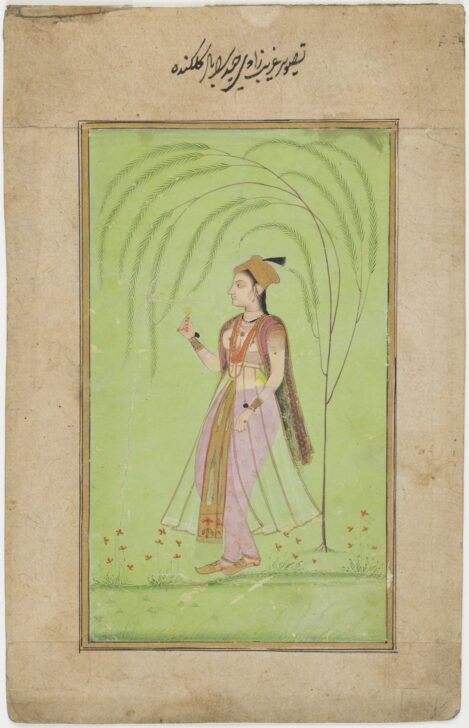Portrait of a lady under a willow
Golconda School

Description
March 28, 2009
In Persian poetry written at India’s courts, beautiful women were often compared with the graceful form of tree limbs. Like India’s ancient stone sculptures of yakshis (female nature spirits) intertwined with the branches of mango trees, this portrait presents a youthful lady beneath an umbrella of willow fronds. The willow’s arched form echoes the curvaceous hips and perfectly round breasts that are revealed through her diaphanous garment. Likely a courtesan, the lady tenders a flower to her face in a common gesture intended to liken its fragrance and form to her own. The seductive appeal of such portraits made the genre among the most common in Indian painting. This one comes from the Deccan plateau of south-central India, which was under the rule of Muslim courts from the sixteenth to twentieth centuries.
(Label for UMMA South and Southeast Asia Gallery Opening Rotation, March 2009)
Subject Matter:
The high plateau of south central India, known as the Deccan, was under the rule of Muslim courts from the sixteenth to twentieth centuries. Painters were summoned from both Persia and the Mughal court to serve local rulers, but once ensconced in the Deccan, they worked in tandem with local artists to develop a distinctive regional style. This profile portrait of a young woman with a flower in her hand adheres to a composition frequently found in Mughal painting, but the surprising contrast of colors—the play of lavender trousers against a lime-green background—is fresh and appealing, and completely Deccani in taste. The stylized sprigs of flowers scattered in the foreground create both a shallow space cell for the figure and a decorative pattern, while the arching willow branches frame her proud visage.
Physical Description:
The lady stands against a bright green background with only a hint of physical setting. There are some ground lines at her feet with springs of red flowers and a simple stylized willow tree that curves around the figure. She stands with her body turning towards her right with her head in profile. She lifts a flower up in her right hand and hangs her left arms down past her waste. She wears tight lavender colored trousers with a diaphanous skirt covering them with a gold and colored brocaded scarf hanging down the center. Her breasts appear bare, but actually the blouse is also sheer, with a darker color at the shoulders and below her breasts. She wears gold brocade slippers and wide bracelets with black pompoms and rings, necklaces, earrings and a scarf hangs from her shoulders. A gold turban with a black aigrette crowns her. The portrait is framed with some gold and black lines and placed on a simple, buff colored border. An inscription in nastaliq‘ script is above the painting.
Usage Rights:
If you are interested in using an image for a publication, please visit https://umma.umich.edu/request-image/ for more information and to fill out the online Image Rights and Reproductions Request Form.